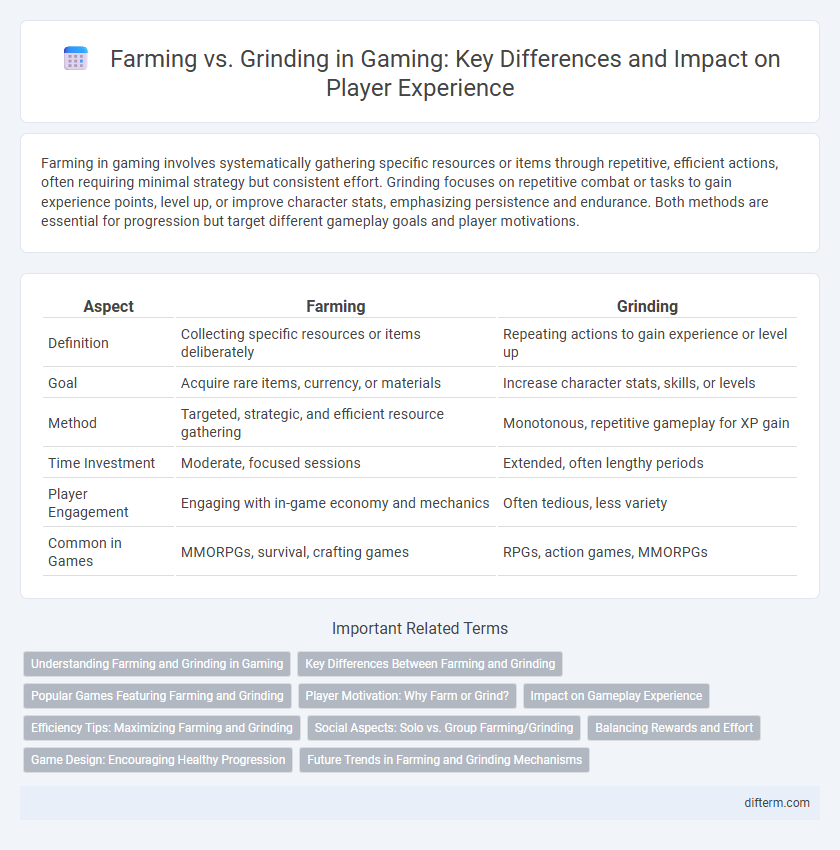Farming in gaming involves systematically gathering specific resources or items through repetitive, efficient actions, often requiring minimal strategy but consistent effort. Grinding focuses on repetitive combat or tasks to gain experience points, level up, or improve character stats, emphasizing persistence and endurance. Both methods are essential for progression but target different gameplay goals and player motivations.
Table of Comparison
| Aspect | Farming | Grinding |
|---|---|---|
| Definition | Collecting specific resources or items deliberately | Repeating actions to gain experience or level up |
| Goal | Acquire rare items, currency, or materials | Increase character stats, skills, or levels |
| Method | Targeted, strategic, and efficient resource gathering | Monotonous, repetitive gameplay for XP gain |
| Time Investment | Moderate, focused sessions | Extended, often lengthy periods |
| Player Engagement | Engaging with in-game economy and mechanics | Often tedious, less variety |
| Common in Games | MMORPGs, survival, crafting games | RPGs, action games, MMORPGs |
Understanding Farming and Grinding in Gaming
Farming in gaming refers to repeatedly performing specific tasks or defeating certain enemies to collect resources, items, or experience points efficiently. Grinding involves continuous, often monotonous play to level up characters or improve skills, usually requiring substantial time investment. Distinguishing between farming and grinding helps players optimize gameplay strategies, balancing resource acquisition with character progression.
Key Differences Between Farming and Grinding
Farming in gaming involves repeatedly gathering specific resources or items in a targeted and efficient manner, often using optimized routes or strategies. Grinding emphasizes prolonged, repetitive combat or task completion to gain experience points, level up, or collect random drops, sometimes without a focused objective. The key difference lies in farming's goal-oriented resource collection versus grinding's broader approach to character progression and item accumulation.
Popular Games Featuring Farming and Grinding
Popular games featuring farming and grinding mechanics include titles like Stardew Valley, Animal Crossing, and Minecraft, where players cultivate resources and manage virtual farms. In contrast, games such as World of Warcraft, RuneScape, and Diablo emphasize grinding through repetitive combat and quest completion to level up characters and obtain rare items. Both styles engage players by balancing resource collection with progression systems tailored to different gaming preferences.
Player Motivation: Why Farm or Grind?
Farming in gaming targets resource accumulation with steady, repetitive actions that satisfy players motivated by progression and long-term goals. Grinding appeals to players seeking challenge and mastery through repetitive tasks that improve skills or rank. Understanding these motivations helps developers design gameplay loops that balance reward frequency and player engagement.
Impact on Gameplay Experience
Farming in gaming involves repetitive collection of resources or items, enhancing strategic planning and long-term progression but can sometimes lead to monotony. Grinding typically requires continuous combat or tasks, significantly boosting character stats and skill levels, which can increase player satisfaction through measurable growth. Both methods impact gameplay experience differently, with farming fostering patience and resource management while grinding drives immediate action and skill improvement.
Efficiency Tips: Maximizing Farming and Grinding
Maximizing farming efficiency in gaming involves identifying high-yield locations and optimizing resource collection routes to reduce downtime. For grinding, maintaining consistent action speed and leveraging experience boosts or multipliers significantly increase progression rates. Combining smart inventory management with periodic breaks prevents fatigue, enhancing overall efficiency in both farming and grinding tasks.
Social Aspects: Solo vs. Group Farming/Grinding
Farmers in games often prefer solo activities for control and pacing, enabling a personal rhythm in resource gathering without reliance on group coordination. Grinders typically engage in group play to enhance efficiency, share strategies, and increase social interaction, promoting teamwork and collective progression. The choice between solo and group methods significantly impacts the gaming experience, influencing social dynamics and player engagement.
Balancing Rewards and Effort
Efficient gaming requires balancing farming and grinding by maximizing rewards while minimizing repetitive effort. Farming targets predictable, steady resource gains through strategic actions, whereas grinding demands intense, repetitive gameplay often yielding variable rewards. Properly balancing these methods enhances player engagement, optimizing both progression speed and enjoyment.
Game Design: Encouraging Healthy Progression
Game design that balances farming and grinding mechanics promotes healthy progression by rewarding consistent player effort without causing burnout. Efficient farming systems provide resource generation through strategic, low-stress gameplay loops, while grinding requires repetitive tasks to gain experience or items, demanding careful pacing to maintain engagement. Successful games integrate these mechanics to foster player motivation, ensuring progression feels rewarding rather than tedious.
Future Trends in Farming and Grinding Mechanisms
Future trends in farming and grinding mechanisms in gaming emphasize automation and AI-driven optimization, enhancing efficiency and player engagement. Adaptive algorithms will personalize resource collection, balancing challenge with reward to prevent monotony. Integration of blockchain technology may also introduce unique, tradeable assets earned through farming and grinding, transforming in-game economies.
farming vs grinding Infographic

 difterm.com
difterm.com